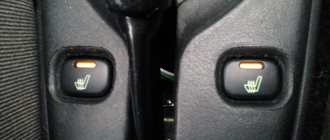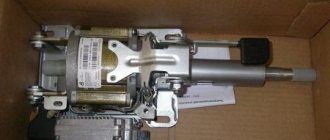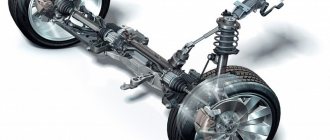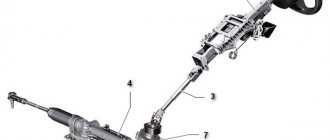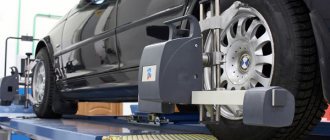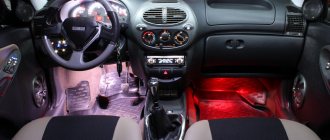When did he appear?
The first patent for a steering wheel heater was registered by the American inventor Reuben Smith in August 1912, and all subsequent authors only brought the invention to fruition, introducing new materials and layouts. The “revolution” occurred in 1983, when Japanese engineers Kazushi Noda, Moryuki Komatsu and Hiroshi Mitsunaga proposed a design consisting of a thermoplate, a thermal converter and a thermal accumulator.
This design made it possible to accumulate heat while the steering wheel was hot, and then release it when the temperature dropped below the set one. In hot weather, a steering wheel with such a system could be cooled. However, the design never found application - now cars are equipped with a simple heater, which is not far removed from its ancestor more than a century ago.
Rules for connecting the mechanism
After the heating elements have been installed on the steering wheel, you can connect the device to power. There are several connection options:
- through the cigarette lighter;
- through wiring specially dedicated for this purpose;
- using unused wires.
The most practical and safe option for arranging power is to connect via a dedicated line from the battery. The algorithm of actions is as follows:
- you need to take two copper rings, which are about 1.5 mm thick, and prepare a power button;
- the rings must be connected to the plus and minus of the electrical wiring of the machine;
- the device switch off button should be placed in the steering column casing located at the bottom - this will be more aesthetically pleasing and convenient;
- on the left overlay you need to make a cutout to install the button using a special stencil;
- then the wires must be soldered to the rings, and then connected to the battery through the fuse and relay;
- copper rings should be attached to the wire with double-sided tape, and then filled with epoxy glue;
- one wire must be positive, the negative can be used from the steering shaft;
- the contact for switching off should be located opposite the rings in the steering wheel; for this you need to make a special hole;
- everything must be carefully isolated to avoid unwanted contacts;
- At the bottom, you should install a thin plate as a spring so that the shutdown button is constantly pressed against the rings: one end of the spring will rest against the steering wheel, the other will press on the contact.
This is interesting: 2 ways to change the oil in an automatic transmission (automatic transmission) yourself
The heating process with this connection will occur quite quickly and evenly. The steering wheel will be noticeably warm after just a few minutes.
How much does it cost on new cars?
As noted above, a heated steering wheel, despite our cold climate, is not found in the list of standard equipment and options for all manufacturers. For example, on Mazda, Renault, Nissan, Citroen, Chevrolet and Mercedes-Benz, a heating pad can only be supplied as an option for an additional fee.
Occasionally, heating is found as a separate option. So, for example, on a BMW 1 Series it will cost (July 2014 prices) 11,168 rubles, and on a Range Rover - 13,500 rubles. Much more often it can be found in special option packages. On the Opel Zafira, the Enjoy package for 18,000 rubles, in addition to a heated steering wheel, includes an air quality sensor, dual-zone climate control and heated electric mirrors. On the Volvo XC60, the winter package for 19,900 rubles also includes heated windshield and washer nozzles.
1 / 3
2 / 3
3 / 3
It also happens that steering wheel heating is included in the standard equipment of a particular configuration. Automakers have different policies here. For example, at Toyota only the expensive SUVs Highlander, Land Cruiser and LC Prado have this coveted option; even the not-so-cheap RAV4 and Camry, not to mention the Corolla, lack it. But Korean manufacturers do not skimp on warmth for the driver’s hands. Kia has a Warm Options package that is included as standard equipment on almost all of the brand's vehicles, including the Rio. Only the cheapest basic Comfort package lacks it.
Kia Heated Steering Wheel Advertising
Installation features
To work at home, it is best to take special heating elements, which are used in car seat heating mechanisms. In stores you can purchase a set such as “Emelya Gorynych”. It is good because it is equipped with a high-quality thermal relay. Thanks to it, the heating will turn off automatically when it reaches a certain temperature.
To make a homemade heated steering wheel, in addition to the relays themselves and heating elements, you need the following tools and materials:
- felt-tip pen;
- knife and epoxy glue;
- double-sided tape and electrical tape;
- sealant;
- device shutdown contact, two copper rings;
- leather steering wheel cover (you can also sew it yourself if you wish);
- soldering iron
This is interesting: Chevrolet Cruze front bumper price: nuances of selection and purchase
To begin the installation process, the steering wheel must be removed. After this, the heating elements are installed first.
The process is a sequence of actions:
- Using a marker, you need to mark the installation locations of the heaters. In this case, the step may be different. The permissible distance between grooves is from 20 to 30 mm.
- After marking the wheel, you need to use a knife to make indentations for the heating elements. Instead of a sharp blade, you can use a special drill with attachments for this.
- The wires can be fixed or left as is. As a result, they will be covered with a cover.
Experts advise placing heating elements on glue, and securing areas of turns and bends with electrical tape. It can be removed when the glue dries. Once it has hardened, the grooves with the heating elements will need to be filled with sealant. Thanks to this, the grooves will not be felt at all under the leather cover. Then the furrows are puttied and the surface of the wheel is leveled with a knife.
Is it possible to do the heating yourself?
What if the steering wheel in the car is not heated, but your hands are asking for warmth? You can install this option yourself, since the design, as we understand, is simple. A set of high-quality heating filaments and wiring costs an average of 3,000 rubles. The cost of installation depends on the complexity of your vehicle's electronics. On inexpensive cars, where a foreign device will not conflict with the on-board computer, installation will cost approximately 5,000 - 6,000 rubles. On expensive cars, in particular Mercedes-Benz (the Germans, as we already wrote, do not have a heated steering wheel), threads have to be introduced into the on-board electrical system. The pleasure will cost 12,000 – 15,000 rubles. Or even higher. Those who like saving money and doing their own repairs can be advised to do without the help of specialists. Instead of an expensive installation kit, buying heating filaments is much cheaper - up to 1,000 rubles. Next you will have to disassemble the steering column, unstitch the steering wheel braid to lay threads under it, and sew it back up. Power and controls can be configured to your liking. Someone puts the heating switch on a separate button and places it in a random place in the cabin. Some people prefer to connect the system to the seat heating button to turn them on synchronously. Just in case, let’s make a reservation that you can only engage in an independent “collective farm” if you have some ideas about electrical engineering, and even better, experience working with automotive electricals. If there is neither one nor the other, it is better not to experiment and, in order to avoid troubles, leave the matter to the masters who know their business. There is another alternative - do not bother with installation and buy a braid for the steering wheel with a wire connected through the cigarette lighter connector. This costs from 700 to 1,000 rubles, but it is difficult to use. The wire interferes with steering.
Buy a kit or do it yourself?
The desire to retrofit your car with a heated steering wheel can be realized in 4 ways.
- Buy a kit ready for installation, which will include a thermal switch, heating element, button, relay, wires with a fuse holder. In some systems, a voltage converter with 12V ≥ 30V is included in the circuit to improve efficiency.
- Assemble the installation kit yourself. If you do not take into account the voltage converter, which is not available in all models, the kit consists of elements that are easily available for purchase.
- Install a standard heated steering wheel. You will need to buy a steering wheel, a button and possibly replace the steering column cable. But this is only provided that your car model of later years of production or in expensive trim levels had a heated steering wheel installed as standard.
- Make your own heating using MGTF wire as a heating element. Previously, along with nichrome wire, we considered making a heating element from MGTF wire for heating rear-view mirrors. The same element is often used in the design of heated seats.
To choose your own path, you just need to estimate the cost of the finished kit, the elements separately, and the time costs for installing a heated steering wheel using each method.
Braid
Advantages of installing heated braid:
- heating is powered from the cigarette lighter, so there is no need to interfere with the design of the vehicle’s on-board network;
- Removal and installation takes no more than 2-3 minutes.
For the apparent convenience you will have to pay with serious disadvantages:
- It is impossible to turn on the heated steering wheel while driving. The power cord going to the cigarette lighter will restrict the movements of the steering wheel, which makes it difficult to control the car and is fraught with an accident;
- minor effect. When turned on for a short time, the steering wheel will heat up very little and quickly release heat after removing the braid. We do not recommend driving constantly with this kind of accessory on the steering wheel. Due to its versatility and manufacturing features, the heated braid is poorly fixed to the steering wheel, which may prevent emergency steering in case of a skid;
- the braid, wire and adapter for powering the heated steering wheel will have to be constantly stored in the car.
Tools and materials
To install the heated steering wheel kit you will need:
soldering iron, flux and some solder;- tool for removing the steering column trim, steering wheel. You can find detailed removal instructions in the repair and operating manual for your vehicle;
- a feather drill for a hole in the steering wheel spoke for a thermal switch;
- universal glue "Moment". The glue will not allow the conductive fabric to wrinkle or peel off from the rim when connecting and re-stitching.
What's next?
No car on sale today has a feature like adaptive climate control for the steering wheel, which can not only warm it up, but also cool it?
However, every year manufacturers are forced to introduce something new to the market so that buyers get the impression of constant progress and the need to buy its fruits. Therefore, it is very possible that the day will come when a unique premium and innovative steering wheel with climate control is announced to us in a press release. And let his idea come up with in 1983... Photo: powerfuluk.com, Kia, Land Rover, Hyundai, Kia, Opel, BMW
